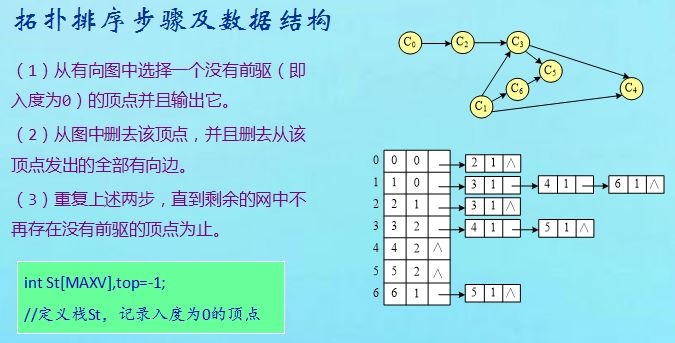数据结构例程——拓扑排序
2015-11-15 09:50
387 查看
本文是[数据结构基础系列(7):图]中第11课时[拓扑排序]的例程。

(程序中graph.h是图存储结构的“算法库”中的头文件,详情请单击链接…)
[代码]

(程序中graph.h是图存储结构的“算法库”中的头文件,详情请单击链接…)
[代码]
#include <stdio.h>
#include <malloc.h>
#include "graph.h"
void TopSort(ALGraph *G)
{
int i,j;
int St[MAXV],top=-1; //栈St的指针为top
ArcNode *p;
for (i=0; i<G->n; i++) //入度置初值0
G->adjlist[i].count=0;
for (i=0; i<G->n; i++) //求所有顶点的入度
{
p=G->adjlist[i].firstarc;
while (p!=NULL)
{
G->adjlist[p->adjvex].count++;
p=p->nextarc;
}
}
for (i=0; i<G->n; i++)
if (G->adjlist[i].count==0) //入度为0的顶点进栈
{
top++;
St[top]=i;
}
while (top>-1) //栈不为空时循环
{
i=St[top];
top--; //出栈
printf("%d ",i); //输出顶点
p=G->adjlist[i].firstarc; //找第一个相邻顶点
while (p!=NULL)
{
j=p->adjvex;
G->adjlist[j].count--;
if (G->adjlist[j].count==0)//入度为0的相邻顶点进栈
{
top++;
St[top]=j;
}
p=p->nextarc; //找下一个相邻顶点
}
}
}
int main()
{
ALGraph *G;
int A[7][7]=
{
{0,0,1,0,0,0,0},
{0,0,0,1,1,0,1},
{0,0,0,1,0,0,0},
{0,0,0,0,1,1,0},
{0,0,0,0,0,0,0},
{0,0,0,0,0,0,0},
{0,0,0,0,0,1,0}
};
ArrayToList(A[0], 7, G);
DispAdj(G);
printf("\n");
printf("拓扑序列:");
TopSort(G);
printf("\n");
return 0;
}
相关文章推荐
- 【数据结构】求节点的哈夫曼的带权路径长度
- 数据结构例程——每对顶点之间的最短路径
- C++数据结构: 链表
- SDUT OJ数据结构实验之二叉树三:统计叶子数
- SDUT OJ 数据结构实验之二叉树二:遍历二叉树
- SDUT OJ 数据结构实验之二叉树五:层序遍历
- SDUT OJ 数据结构实验之二叉树七:叶子问题
- 第126讲:Hadoop集群管理之Datanode目录元数据结构详解学习笔记
- Java中常用数据结构的实现类 Collection和Map
- 【数据结构】【输入一个整数数组,判断该数组是不是某二元查找树的后序遍历的结果】
- 第125讲:Hadoop集群管理之SecondaryNamenode目录元数据结构详解及其内幕机制学习笔记
- 数据结构(Java)——栈的实现总结
- android hal 学习——数据结构整理
- 旭说数据结构之散列表(哈希表)
- 数据结构 (3.3) 栈
- 2015年大二上-数据结构-栈(5)- 后缀表达式
- 【数据结构实验】二叉树的遍历(栈版)
- 旭说数据结构之用两个栈实现队列
- 【数据结构】二叉排序树BST
- 【数据结构】二叉排序树BST
